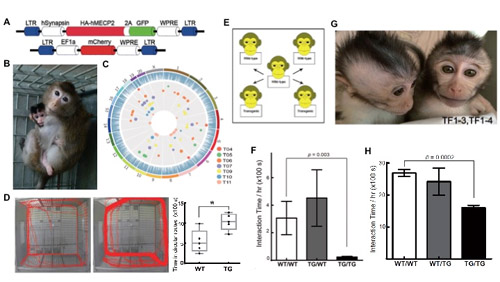
A recent study published in Nature demonstrated that transgenic monkeys overexpressing human autism-related gene MECP2 exhibited autism-like behaviors and germ-line transmission. This work was performed by researchers in Dr. QIU Zilong’s Lab and Dr. SUN Qiang’s team at the Institute of Neuroscience (ION), Shanghai Institutes for Biological Sciences (SIBS), Chinese Academy of Sciences (CAS). This work has successfully constructed a monkey model overexpressing human autism-related gene MECP2. Transgenic monkeys exhibited autism-like behavior, and germ-line transmission of exogenous transgene to offspring was successful, as assayed by genetic and behavior tests.
Autism spectrum disorder is a group of neurodevelopment disorder. Patients usually exhibit defects in social interaction, stereotyped repetitive behaviors, anxiety and emotional difficulties. The treatment of autism and the establishment of autism animal model are critical goals in both medicine and neuroscience.
The methylation CpG island binding protein 2 (MECP2) gene has attracted the attention of researchers because of its unique properties among many autism associated genes. Previous work showed that Rett syndrome, a severe neurodevelopment disorder in girls, was caused by mutations of MECP2. On the other hand, duplications of the MECP2 gene led to the MECP2 duplication syndrome, associated with severe autistic behaviors. In animal models, although MECP2-null mice recapitulate most developmental and behavioral defects seen in patients with Rett syndrome, it has been difficult to identify autism-like behaviours in the mouse model of MeCP2 overexpression.
In order to generate autism models in monkeys, QIU’s Lab and the Suzhou Non-human Primate Facility of ION constructed a neural specific MECP2 overexpressing transgenic monkey by lentiviral infection (Fig. A,B). Human MECP2 transgenes were effectively inserted into the genome of transgenic monkeys, confirmed by target sequence capture and deep sequencing analysis (Fig.C). Western blot and immunohistochemical experiments showed that the human MECP2 transgene was properly expressed in the central nervous system.
In further study of behavioral phenotypes of MECP2 transgenic monkeys, basic development measurements and an array of behavioral tests were carried out. As compared to the wild type monkeys, MECP2 transgenic monkeys gained weight more slowly, had fatty acid metabolism abnormalities, exhibited a higher frequency of repetitive circular locomotion (Fig.D) and showed increased stress responses in threat-related anxiety test. Most importantly, the transgenic monkeys showed less social interaction time with wild-type monkeys (Fig.E), and also a reduced interaction time when paired with other transgenic monkeys in social interaction tests (Fig.F). The cognitive functions of the transgenic monkeys were largely normal in the Wisconsin general test, although some showed signs of stereotypic cognitive behaviours. These phenotypes were very similar to patients with MECP2 duplication syndrome.
F1 offspring of MeCP2 transgenic monkeys (Fig.G) were generated by intracytoplasmic sperm injection with sperm from one F0 transgenic monkey, showing germline transmission and Mendelian segregation of MeCP2 transgenes in the F1 progeny. Moreover, F1 transgenic monkeys also showed reduced social interactions in the pairing social test, similar to their parental monkeys (Fig.H).
In this project, QIU’s Lab and the ION Suzhou Facility established a MECP2 transgenic monkey model. The MECP2 transgenic monkeys exhibited autism-like phenotypes, including anxiety responses and defects in social behaviors. F1 transgenic monkeys was generated by intracytoplasmic sperm injection, and also showed autism-like behaviors. Together, this work demonstrated the feasibility and reliability of using genetically engineered non-human primates to study brain disorders.
This work entitled “Autism-like behaviors and germ-line transmission in transgenic monkeys overexpressing MeCP2” was published online in Nature on January 26, 2016. LIU Zhen and LI Xiao are the first authors with equal contribution. This work was supported by CAS Strategic Priority Research Program (XDB02050400), the 973 Program of the Ministry of Science and Technology of China (2011CBA00400), and grants from the National Nature Science Foundation of China.

Figure legend: (A) lentiviral expression cassette. (B) Image of newborn MECP2 transgenic monkey. (C) Genome-wide distribution of transgenes in F0 TG monkeys. (D) Alterations in locomotion activity. (E) Paradigm of social test within group. (F) Interaction time of social test within pair of F0. (G) Image of newborn F1 MECP2 transgenic monkey. (H) Interaction time of social test within pair of F1. (Image by Dr. QIU Zilong)

86-10-68597521 (day)
86-10-68597289 (night)

52 Sanlihe Rd., Xicheng District,
Beijing, China (100864)

